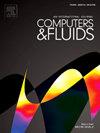Break-up of the Taylor bubble
IF 2.5
3区 工程技术
Q3 COMPUTER SCIENCE, INTERDISCIPLINARY APPLICATIONS
引用次数: 0
Abstract
High-resolution direct numerical simulation is used to study the motion of a Taylor bubble in a cylindrical microtube under conditions that lead to the bubble break-up. It is observed that the initial bubble elongates and deforms such that its front part retains a bullet-like shape while its back part forms a skirt shape. Subsequently, the carrier fluid surrounded by the skirt penetrates into the bubble forming a finger that transitions into a bulb shape. The bulb then increases in size until it touches the near-wall liquid film and as a result splits the bubble into two comparable daughter bubbles. Various dynamical features of this break-up process are explored and described in detail.

泰勒泡沫破裂
采用高分辨率直接数值模拟方法,研究了导致气泡破裂的条件下泰勒泡在圆柱形微管中的运动。观察到初始气泡的伸长和变形使其前部保持子弹状,而后部形成裙形。随后,被裙部包围的载体流体渗透到气泡中,形成一个转变成球状的手指。然后,灯泡的大小增加,直到它接触到近壁的液体膜,结果将气泡分裂成两个类似的子气泡。研究并详细描述了这一分裂过程的各种动力学特征。
本文章由计算机程序翻译,如有差异,请以英文原文为准。
求助全文
约1分钟内获得全文
求助全文
来源期刊

Computers & Fluids
物理-计算机:跨学科应用
CiteScore
5.30
自引率
7.10%
发文量
242
审稿时长
10.8 months
期刊介绍:
Computers & Fluids is multidisciplinary. The term ''fluid'' is interpreted in the broadest sense. Hydro- and aerodynamics, high-speed and physical gas dynamics, turbulence and flow stability, multiphase flow, rheology, tribology and fluid-structure interaction are all of interest, provided that computer technique plays a significant role in the associated studies or design methodology.
 求助内容:
求助内容: 应助结果提醒方式:
应助结果提醒方式:


